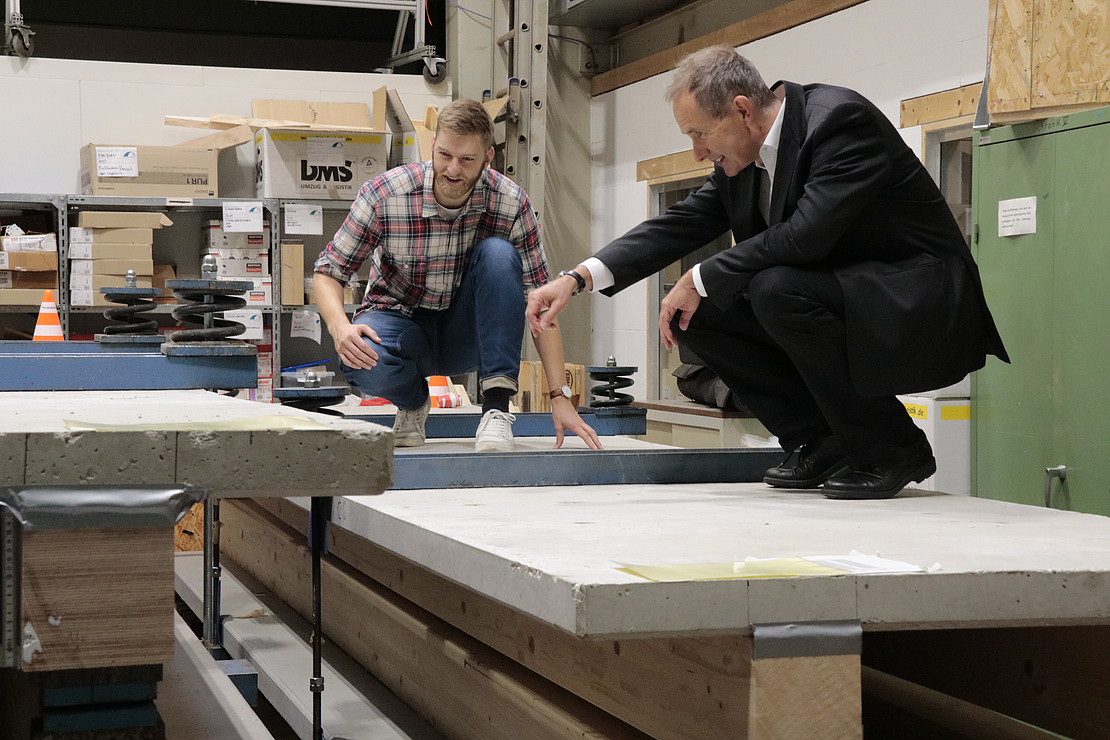This page contains automatically translated content.
Schneller und umweltfreundlicher Bauen mit Holz-Beton-Verbundelementen
 Image: University of Kassel.
Image: University of Kassel.Decken von Wohn- oder Bürogebäuden werden üblicherweise aus frischem Stahlbeton gegossen. Dieser ist sehr günstig, aber schlecht für die Umwelt. Die Betonherstellung verursacht Milliarden Tonnen CO2‑Emissionen jährlich. Zudem ist der nasse Beton nicht optimal zu verbauen: Durch den Frischbeton wird unter anderem unerwünschte Feuchtigkeit in die Konstruktion getragen. Wie es durch eine Klebtechnik effizienter geht, haben Forscher der Uni Kassel gemeinsam mit Partnern im Projekt SpeedTeCC herausgefunden.
Holz kann die Lösung sein
Bei der neu entwickelten Schnellklebtechnik werden Holzbalken mit Betonfertigteilen verbunden. Die Betonplatte liegt dabei flächig auf den Balken. Durch das eingearbeitete Holz braucht es bis zu 70 Prozent weniger Beton für eine Gebäudedecke. Neu ist die Verbundmethode: Dafür verwenden die Forscher ein Metallgitter, das zwischen die Klebefugen von Holz und Betonfertigteil gelegt wird. An beiden Enden des Metallgitters wird Strom angeschlossen, sodass die Verbundfuge gezielt erhitzt und verklebt wird.
Das macht das Verfahren besonders praxistauglich. „Auf der Baustelle ist es oft kalt, Bauteile können so nicht gut verklebt werden. Unser Ziel war ein einfaches, handhabbares Verfahren für die Praxis. Durch das SpeedTeCC-Verfahren sind wir nicht mehr abhängig von der Außentemperatur. Damit ist das Verkleben von Holz und Betonfertigteil auch bei niedrigen Temperaturen möglich“, erklärt Jens Frohnmüller vom Fachgebiet Bauwerkserhaltung und Holzbau. Er hat das Projekt gemeinsam mit Fachgebietsleiter Prof. Dr.-Ing. Werner Seim an der Uni Kassel betreut.
In der Praxis anwendbar
Das Verfahren kann auf der Baustelle viel Zeit sparen. Durch die Arbeit mit Betonfertigteilen kann ein Haus in kurzer Zeit gebaut werden. Stahlbeton muss dagegen erst einmal aushärten und trocknen.
Die Forscher begannen mit kleinen Proben für die statistische Auswertung, die bei jedem Versuch einen Maßstab größer wurden, um die Tragfähigkeit und die Dauerhaftigkeit des Klebeverbunds zu prüfen. Durch diese Versuche kann sichergestellt werden, dass der Klebeverbund zwischen Holz und Beton nicht nur kurzfristig, sondern über die gesamte Lebensdauer des späteren Gebäudes beständig bleibt. „Das i‑Tüpfelchen sind unsere 1:1‑Deckenversuche. Wir haben zwölf Deckenelemente mit unserer neuen Methode hergestellt“, sagt Frohnmüller. Diese Bauteile sind 6 Meter lang und 1,30 Meter breit. Der Versuch gelang. Die Bauteile überzeugten bei den Tests zu Trag-, Verformungs- und Schwingungsverhalten. Damit ist die Schnellklebtechnik für den mehrgeschossigen Holzbau geeignet.
Die neue Schnellklebtechnik für Holz-Beton-Verbundelemente soll möglichst schnell Eingang in die Praxis finden. „Mit dem Folgeprojekt möchten wir das Verfahren weiter in Richtung Marktreife und in die Serienproduktion bringen“, sagt Frohnmüller. Hierbei soll der Fokus auf einer möglichst einfachen und robusten Herstellungsmethode liegen.
An SpeedTeCC hat die Universität Kassel gemeinsam mit der Technischen Universität Braunschweig, dem Institut für Füge- und Schweißtechnik (IFS) und dem Fraunhofer-Institut für Holzforschung, Wilhelm-Klauditz-Institut (WKI) geforscht. Derzeit arbeiten die Kooperationspartner an einem Leitfaden, um die Methode der Industrie zur Verfügung zu stellen. Diese Dokumentation wird in den nächsten Monaten auf der Homepage des Internationalen Vereins für technische Holzfragen (iVTH) in Braunschweig, welcher das von der Industriellen Gemeinschaftsforschung IGF, AiF e. V. und BMWi geförderte Projekt betreut hat, verfügbar sein.
Kontakt:
Jens Frohnmüller M. Eng.
Tel.: 0561 804 – 2685
E-Mail: frohnmüller@uni-kassel.de